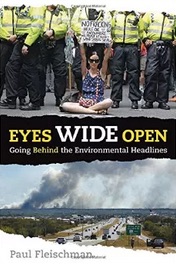Eyes Wide Open: Going Behind the Environmental Headlines
Reviewed by Sandy and Tom Farley
May 1, 2015
 By Paul Fleischman. Candlewick Press, 2014. 203 pages. $17.99/hardcover; $9.99/paperback or eBook. Recommended for ages 14 and up.
By Paul Fleischman. Candlewick Press, 2014. 203 pages. $17.99/hardcover; $9.99/paperback or eBook. Recommended for ages 14 and up.
Buy on FJ Amazon Store
While this book was written for high school students, we think many middle schoolers could handle it well. Paul Fleischman invites young people to notice history that is taking place around them, especially in the area of public attitudes about environmental policy. He connects this to other lessons of history and political science commonly taught in grades 9 through 12.
Paul Fleischman is an award-winning author of nonfiction, fiction, and poetry for young readers. In an interview in Bay Area Parent (January 2015 issue), he said, “The media, alas, has been as distorted by money as our government has. That makes it crucial for teens and adults alike to know how to test information before swallowing it, and how to notice the tools of persuasion.”
He uses climate change as a way to examine how we look at the world. He asks us to see who has “special interests” that would color their interpretation of the facts. He wants us to notice if “common sense” goes unquestioned, problems get solved “out of sight” (and presumably out of mind), and information is presented so much “in the now” that its history and projections are not explored. He points out with examples how when the news is bad and we—humanity—might be at fault, standard ego “defense mechanisms” take over: denial, projection, and regression.
He asks how our systems of democracy and capitalism work for and against honest appraisals of our world situation and actions that can be taken to mitigate the problems. How do our attitudes or mindsets enter into the picture? Do we believe science will come to the rescue? Is there no way to scale back our lifestyle? How do people in more densely populated countries function differently in relation to scarce resources? Does a smaller world require bigger government? These are questions adults as well as teens need to ponder.
The last chapter, “Eyes Abroad and Ahead,” offers examples of positive changes being brought about, although it is clear that Fleischman feels we will be playing catch-up for many years. Our planet is not doomed, even though residents of some low-lying places will certainly need to relocate. We can do things to build changes in attitudes up to the tipping point of public opinion that will lead to concerted action on energy, population, and climate change.
We recommend this short book to schools as supplemental material for a history or earth science class, both for its process and for the glossary, bibliography, and references to websites. We recommend it to teens whose schools are not yet opening their eyes. We recommend it to those who homeschool for use in middle school levels, so their students gain the tools for evaluating public discourse. Adults might find the descriptions of how policy making really works in this country refreshingly candid.



Comments on Friendsjournal.org may be used in the Forum of the print magazine and may be edited for length and clarity.